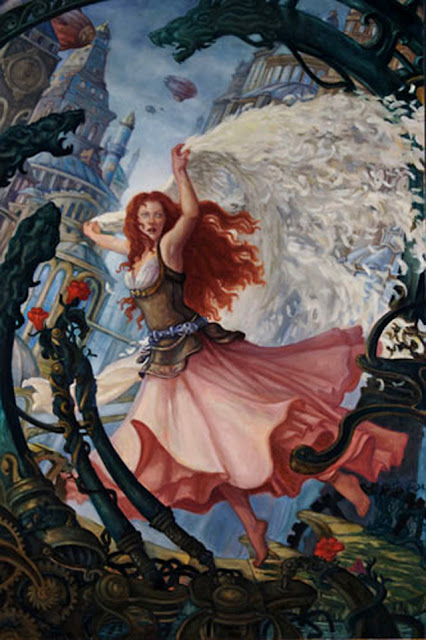How to make a very fantastical fairy tale movie relevant to people today? Use social media. Or, should I say, watch this Queen use social media and get this incredibly familiar feeling you've seen her somewhere before...
First seen on Maria Tatar's Breezes From Wonderland blog, I was so tickled to see this use of advertising and had to share and make a few comments.
But first, if you haven't seen it yet, take a look:
Do we know this Queen? I think we do.
I really like that this clearly shows the archetype is not only (eerily) familiar and (sadly) relevant today but puts yet another modern spin on the Snow White story. (It may even make a few people do a double take at their own actions... one can hope.)
The video reminds me of the Christmas Story as viewed/told via Facebook. It's well done and, again, clearly shows how people simply haven't changed as much over hundreds of years as we (would like to) think.
This is also another example of how to effectively use various forms of social media for spreading the word about niche ideas and topics, how to network with people who are normally scattered and hard to find (since they're not necessarily the ones in popular circles with lots of money to "announce" their presence online) which is exactly the point of viral marketing (well, that, and to persuade these people to spend their money but that's another topic).
Why am I spending so much time on this little piece of advertising? Because it suggests how effective a tool social media can be for many reasons and what magic may be lying at the fingertips of the fairy tale community - if we can figure out how to harness it. We just need to figure out what it is we actually want to do for fairy tales first. It's time to think outside the box.
It's clear even the big media outlets are struggling to keep up with this technology's potential but you know who's figured out how to make this work? Evil Queens. And Kings. And other not-so-stellar types. Social media is this very strong neutral resource - or power, if you like - and has already proved to be very effective when put to use by deviant minds (identity theft, hacking the CIA and blocking resources). But what this really means is that it also has great potential for good too. It just takes a different type of heart to find how. Did you know sites such as Care2Causes and other petition sites have saved lives, stopped abuse, highlighted and halted corrupt lawmaking and much much more? All because people take 3 seconds to sign their name and spread the word (ie. expose) what's actually happening.
What does this have to do with fairy tales? Everything. Imagine if Snow White (who already had a high profile and was a clear winner in any popularity contest) had the tools of social media at her fingertips. No more running alone through the woods, hiding out or being cornered alone. What if the little bird spreading news about Snow White was actually a tweet? Emergency services would have arrived before she'd have hit the floor. The mirror of today? It's those invisible thousands who's interest you've caught and who anonymously "like", comment on or even just mention what you've said to someone else. In it's own way it's magical and, like magic, using it comes with both risk and reward. These are the tools of today and the way stories are told, popularized and archived. The nice thing about this era? No wizard skills required. Being involved is often simpler than checking your email. We owe it to ourselves and the tales we love to use this to our advantage.*
The question would then no longer be "Would you dare "unfriend" this Evil Queen?" but "Would she dare "unfriend" you?"
Something to think about.
*Yes: there are a billion people trying to teach you how to "market yourself" using social media these days and yes, it CAN be both overwhelming and a fulltime job maintaining it - IF you let it. The key is to make it work FOR YOU (re the fairy tale community: "us") - not have you work for it (which is what some sites are trying to do. You and your information are far more useful to them if they have you do all the work).































